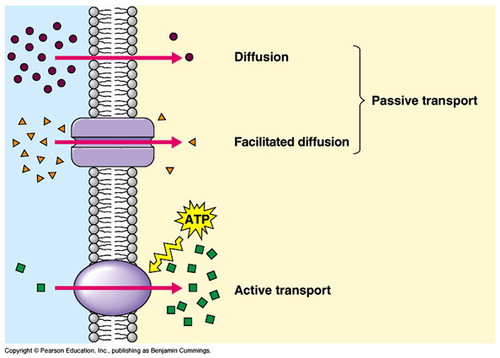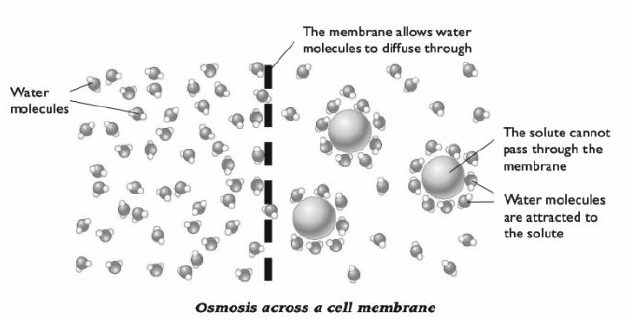Transport across Plasma Membrane of CELL and MCQs for NEET, GPAT and CSIR NET JRF Exam
Transport of material across the plasma membrane of cell is essential for life of a cell. Certain substances must move into the cell for metabolic activities; while some substances which are produced by the cell or are waste products should move out of the cell. Majorly, there are two transport processes
ACTIVE TRANSPORT:-

in this process, the substance crosses its semi-permeable plasma membrane and move up its concentration gradient that is from a lower to higher concentration, using chemical energy . there are two sources of energy available for transport: energy obtained from hydrolysis of ATP; and energy stored in ionic concentration gradient. Active diffusion is mainly of two types-
1.Primary active transport:-
In this process, energy is derived from the hydrolysis of ATP. The carrier proteins that facilitates this process are called as pumps. The process majorly allows the sodium ions to move out of the cells and potassium ions to enter in; and the carrier which facilitates this movement is known as sodium-potassium pump. ATPase is a enzyme that hydrolysis ATP. The steps through which movement of sodium and potassium occurs are as follows-
- Three (Sodium) Na ions in the cytosol of cell binds to the pump.
- As the Na ions binds, it triggers hydrolysis of ATP into ADP and also the potassium group attaches to the pump. These chemical reactions changes the shape of pump protein. Thus the pump allows the 3 Na ion molecules to expel into the extracellular fluid.
- Now as the shape of the pump has changed, it allows 2 potassium ion to bind. Binding of K+ ions triggers the release of potassium group from the pump protein. This reaction changes the shape of pump again.
- As the shape of pump changes, it facilitates the expel of potassium ions into the cytosol of the cell. And in this ways the cycle continues.
2. Secondary active transport:-
Energy stored in Na and H+ concentration gradient is used to transport other substances against there own concentration gradient. Since Na and H+ ions are transported through active transport, so the secondary active transport indirectly uses energy from the hydrolysis of ATP. If the transporters that facilitates secondary active transport both the substances in same direction; then they are called symporters. when the transporters transports the substances in opposite direction then they are called antiporters.
PASSIVE TRANSPORT:-

In this process, the substances crosses its semipermeable plasma membrane and move down its concentration gradient, without the use of energy. is divided in different types which as follows-
1.Simple Diffusion
This is a type of passive process, in which substances move freely across there plasma membrane without the help of membrane transport proteins. Hydrophobic and non-polar molecules move using simple diffusion; which includes- oxygen, CO2, nitrogen gas, fatty acids, steroids and fat soluble vitamins like (Vitamin A, D, E, K). some of the small uncharged polar molecules like water, urea and small alcohol can also move through simple diffusion.
2.Facilitated Diffusion
In this type of transport process, the molecules which are highly polar and uncharged move across the plasma membrane with the help of membrane transport proteins. The membrane protein can either be membrane channel o membrane carrier.
a. Channel-mediated facilitated diffusion:-
membrane channels are mostly ion channels, which allows the ions which are too hydrophilic to pass through the nonpolar plasma membrane. In a plasma membrane, there are numerous of K+ ion and Cl- ion cannels and very fewer are Na+ and Ca ion channels.
b. Carrier-mediated facilitated diffusion:-
In this process, solute binds to a specific side of the carrier, and after the carrier undergoes changes in its shape, it releases the solute at the other side of the plasma membrane. Firstly the solute binds to the side having higher concentration. The substances which transports through this process are- glucose, fructose, galactose and some vitamins.
3.Osmosis

It is a type of diffusion in which there is a net movement of solvent through a selectively permeable membrane. The main solvent for the cells is water. During osmosis, water molecules passes through the plasma membrane in two-
- by moving through the lipid bilayer, as studied in the simple diffusion.
- by moving through aquaporins, integral membrane proteins which acts as water channels.
Multiple choice questions(MCQs)
1. Why is transport across the plasma membrane necessary?
A. transport of substances for metabolic activities
B. movement of waste product out of cell
C. movement of substances produced by cells
D. all of the above
2. Which of the following methods does not require any carrier or channel for transport of substances?
A. secondary active transport B. facilitated diffusion
C. simple diffusion D. primary active transport
3. Which substances are transported through facilitated diffusion?
A. galactose B. urea
C. oxygen D. alcohol
4. Match the following-
a. simple diffusion 1. Movement of charged substances
B. secondary active transport 2. Energy from hydrolysis of ATP
c. primary active transport 3. Stored energy from ionic gradient
D. facilitated diffusion 4. Movement without and membrane protein
5. Which type of movement occurs when Na/K pump is used?
A. Na ions moves out of the cell and K+ move in
B. K+ ion moves out of cell and Na ion move in
C. both Na and K+ ions move inside the cell
D. both Na and K+ move out of the cell
6. which method facilitates the movement of water molecules?
A. simple diffusion B. facilitated diffusion
C. osmosis D. primary active transport
7. Which of the following statement is NOT true?
A. chemical changes leads to change in shape of pump
B. symporters are the one which moves substances in diff direction
C. Vitamin K is transported through simple diffusion
D. in passive transport, the substance moves down its concentration gradient
8. Which substance is transported through secondary active transport?
A. urea B. water
C. O 2 d. none of the above
9. What is the source of energy in active transport?
A. from sunlight B. hydrolysis of ATP
C. energy stored in ionic concentration gradient D. both A and C
10. In what case, the transporters are known as antiporters?
A. when 2 substances move in same direction
B. when 2 move in same direction and 1 in opposite
C. when 3 move in same direction
D. when 2 substances move in opposite direction
ANSWERS:-
1. all of the above
2. simple diffusion
3. galactose
4. a – 4 b – 3 c – 2 d – 1
5. Na ions move out of the cell and K+ ion move in
6. osmosis
7. symporters are the one which moves the substances in opposite direction
8. none of the above
9. both B and C
10. when 2 substances move in opposite direction
Participate in Online FREE GPAT TEST: CLICK HERE
Participate in Online FREE Pharmacist TEST: CLICK HERE
Participate in Online FREE Drug Inspector TEST: CLICK HERE
REFERENCE: 1. Ross and Wilson-Anatomy and physiology in health and illness; 12th edition; page no.-: 36-37.
2. Gerard J. Tortora -Principles of anatomy and physiology; edition twelfth ; page no.-: 66-72.